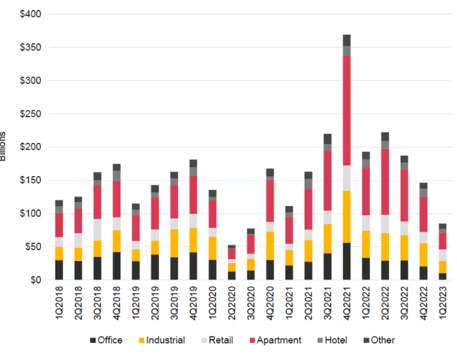
National home prices reach record high amid signs of weakening market, with the Pacific division experiencing sharp price declines.
Existing-home sales hampered by housing inventory shortage as sellers hold on to lower-rate mortgages, hindering market growth.
2. Opportunities remain in US real estate service market despite headwinds
US real estate transactions, 2022

For more information, request a free sample Report
The latest Federal Housing Finance Authority (FHFA) House Price Index (HPI) shows national home prices rose at a seasonally adjusted rate of 0.7% between March and April and 3.1% from a year ago, culminating in the index reaching a new record high of 400 in April. The FHFA HPI is a collection of indices measuring single-family home values across all 50 states and over 400 cities using data derived from conforming mortgages provided by Fannie Mae and Freddie Mac.
The census divisions East South Central and New England showed the biggest 12-month price gains at 6.1% and 6%, respectively, according to the index. The Pacific experienced the sharpest price declines from last year at -3.8%.
Though existing-home median sales prices are down from their eye-watering June 2022 peaks, prices have been creeping back up since February.
The median existing-home sales price in May rose to $396,100, according to the National Association of Realtors (NAR). However, this is down 3% from a year ago and the fourth consecutive month of year-over-year national home price declines after a 131-month streak of record increases.
2. Some Experts Foresee Sluggish Housing Market Recovery
 Visit A link Request for Custom Report
Visit A link Request for Custom Report
Although weekly averages for 30-year mortgage rates are down from their fall 2022 peak, if the ongoing oscillation between 6.5% and 7% continues—or rates break through 7% again—it’s hard to imagine housing market conditions significantly improving anytime soon.
Considering there are still 91% of borrowers with mortgage rates below 6% and roughly 82% of homeowners sitting on rates below 5%, according to Redfin, a sustained uptick in mortgage applications isn’t likely to materialize in the immediate future.
“Purchase applications increased for the third consecutive week to the highest level of activity since early May but remained more than 20% lower than year-ago levels,” said Joel Kan, vice president and deputy chief economist at the Mortgage Bankers Association. Existing-home sales continued to be held back by a lack of for-sale inventory as many potential sellers are holding on to their lower-rate mortgages.”
Mortgage originations amounted to only $344 billion in the first quarter of 2023, their lowest total since the second quarter of 2014, according to a Freddie Mac report. Meanwhile, though existing-home sales did record a nominal gain of 0.2% from April to May, sales are down 20.4% from a year ago, per NAR.
The US real estate market remains a dynamic and influential force, shaped by various factors, including economic conditions, population trends, technological advancements, and shifting consumer preferences. Over the years, it has shown resilience and adaptability, with periods of both growth and challenges. Despite occasional fluctuations, the market continues to hold significant potential for investors, homeowners, and industry professionals alike.
For more insights on market intelligence, refer to the link below: –
US Real Estate Industry
The post Will Innovation and Demand Drive Unprecedented Growth in the US Real Estate Services Market? : Ken Research appeared first on Ken Research.








